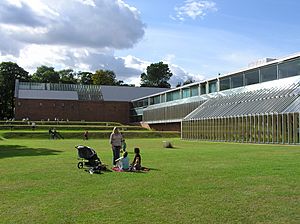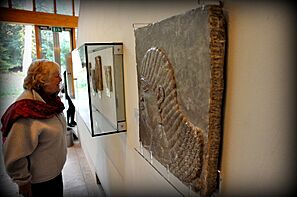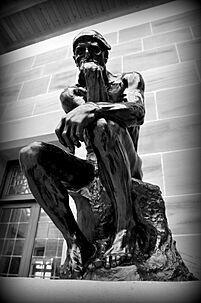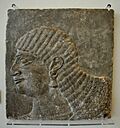Burrell Collection facts for kids
 |
|
| Lua error in Module:Location_map at line 420: attempt to index field 'wikibase' (a nil value). | |
| Established | 1983 |
|---|---|
| Location | Glasgow, Scotland |
The Burrell Collection is a famous museum in Glasgow, Scotland. It is filled with thousands of amazing artworks and historical objects from all over the world. The collection was a gift to the city from the art collector Sir William Burrell and his wife, Constance, Lady Burrell.
The museum first opened in 1983. It was recently updated and reopened in March 2022. In July 2023, it won the Art Fund Museum of the Year award, a very important prize for museums in the United Kingdom.
Contents
The Story of the Collection
The incredible collection was put together over many years by Sir William Burrell. He was a very successful Glasgow businessman who owned a shipping company. He and his wife, Constance, loved art and collected over 9,000 items.
Around 1930, they decided they wanted to share their amazing collection with everyone. They officially gave it to the city of Glasgow in 1944. Sir William had already given some paintings to the Kelvingrove Art Gallery and Museum, and he trusted its director, Dr. T. J. Honeyman. Dr. Honeyman helped convince the Burrells that Glasgow would be the perfect home for their treasures.
Finding the Perfect Home
Sir William had specific rules for the new museum. He wanted it to be in a special building in the countryside, away from the busy city. He wanted the location to be at least 16 miles (about 26 km) from the center of Glasgow. He even gave £450,000, a huge amount of money at the time, to help build it.
Finding the right spot was difficult. The city looked at many places. One location was almost chosen, but then it was discovered that a coal mine was going to be built nearby. This would have created pollution that could damage the art, so the plan was cancelled.
Finally, the perfect solution was found. The city was given a large estate called Pollok Country Park. It was the former home of a family called the Stirling-Maxwells. Even though it was only 3 miles (about 5 km) from the city center, its huge park gave it the peaceful, countryside feeling Sir William wanted. The government also helped with money, and in 1967, work on the new museum could finally begin.
A Special Museum Building
Designing the Museum
In 1970, a competition was held to find the best design for the museum. The winning architects were Barry Gasson, John Meunier, and Brit Andresen. They designed a modern building that was inspired by Scandinavian architecture.
They wanted the building to feel connected to the park around it. They used large windows to let in lots of natural light, which helps visitors see the art clearly. They also designed the building so that some of the largest art pieces, like ancient stone doorways, are built right into the walls. This makes it feel like the building itself is part of the collection.
The museum is shaped like an "L". The entrance leads you through a 16th-century stone archway into a modern building. Inside, there are galleries on two levels, a restaurant with views of the park, and even three rooms recreated to look just like the ones in the Burrells' home, Hutton Castle.
Opening and Awards
The museum was opened by Queen Elizabeth II on October 21, 1983. It was a huge success, with over a million visitors in its first year. The building won many awards and is considered one of Scotland's best modern buildings. In 2013, it was given A-listed status, which means it is officially recognized as a building of special architectural and historic importance.
A Modern Makeover
The museum closed in 2016 for a major renovation. The project cost over £68 million and aimed to repair the building, add more gallery space, and make it more environmentally friendly. It reopened to the public on March 29, 2022. King Charles III visited later that year for the official reopening ceremony. The updated museum has also won many new awards.
Inside the Collection
The Burrell Collection has over 9,000 objects that span 6,000 years of history. You can see everything from ancient artifacts to modern paintings.
Art from China
Sir William began collecting Chinese art around 1910. The museum now has one of the best collections of Chinese art in the UK. It includes ancient pottery, beautiful carved jade, and bronze statues from different periods of Chinese history.
Islamic Art
The collection features beautiful art from the Islamic world. There are colorful ceramics, detailed textiles from Turkey, and amazing carpets from Iran and India. One of the most famous pieces is "The Wagner Garden Carpet," a stunning Persian carpet from the 1600s.
Medieval Treasures
The museum is famous for its collection of art from the Middle Ages.
- Art and Sculpture: You can see religious art, including wooden and stone statues and furniture from old churches.
- Tapestries: There are over 200 tapestries, which are large, woven pictures that once hung on the walls of castles.
- Stained Glass: The museum has over 700 beautiful stained glass panels from churches and cathedrals across Europe. Many show colorful coats of arms.
French Paintings
Sir William also loved French art. The collection includes paintings by famous Impressionist artists like Degas and Cézanne. He especially liked the work of Degas, and the museum has one of the world's largest collections of his art, with over 20 pieces.
Art with a Difficult Past
During the 1930s and 1940s, before and during World War II, some art was unfairly taken from Jewish collectors by the Nazi party in Germany. Years later, museums all over the world, including the Burrell Collection, began to research the history of their artworks to see if any had been stolen. This is called provenance research.
Glasgow Museums found that a few pieces in the Burrell Collection had come from forced sales. They worked with a special group called the Spoliation Advisory Panel to do the right thing. For a painting by the artist Chardin and a 16th-century tapestry, the museum made payments to the families of the original owners. The artworks remain in the museum for everyone to see, but this action helped to correct a historical wrong.
How to Visit
The easiest way to get to the Burrell Collection by train is to go to Pollokshaws West, which is about a 10-minute walk away.
The museum is located in Pollok Country Park, which is also home to Pollok House. A free shuttle bus runs through the park, connecting the museum and Pollok House.
Gallery
See also
 In Spanish: Burrell Collection para niños
In Spanish: Burrell Collection para niños
- List of Category A listed buildings in Glasgow
- List of post-war Category A listed buildings in Scotland











